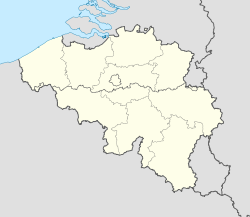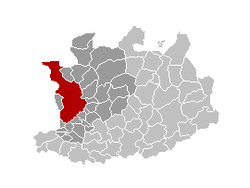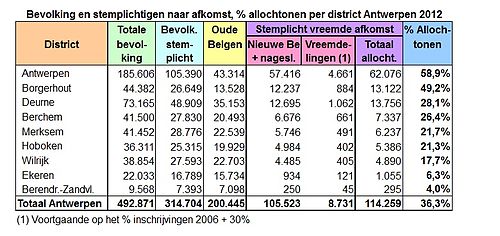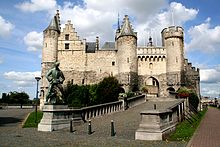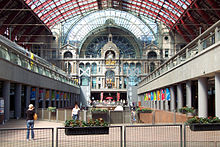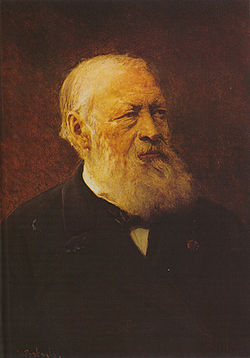
Antwerp
Background to the schools Wikipedia
This Schools selection was originally chosen by SOS Children for schools in the developing world without internet access. It is available as a intranet download. Click here to find out about child sponsorship.
| Antwerp Antwerpen (Dutch) |
|||
|---|---|---|---|
| — Municipality of Belgium — | |||
|
|||
|
|
|||
| Coordinates: 51°13′N 04°24′E | |||
| Country | Belgium | ||
| Region | Flemish Region | ||
| Community | Flemish Community | ||
| Province | Antwerp | ||
| Arrondissement | Antwerp | ||
| Government | |||
| • Mayor (list) | Bart De Wever ( N-VA) | ||
| • Governing party/ies | N-VA, CD&V, Open Vld | ||
| Area | |||
| • Total | 204.51 km2 (78.96 sq mi) | ||
| Population (1 January 2011) | |||
| • Total | 493,517 | ||
| • Density | 2,400/km2 (6,300/sq mi) | ||
| Demographics | |||
| • Foreigners | 13.65% (1 July 2007) | ||
| Postal codes | 2000-2660 | ||
| Area codes | 03 | ||
| Website | www.antwerpen.be | ||
Antwerp (English: /ˈæntwɜrp/; Dutch: Antwerpen, [ˈɑnt.β̞ɛr.pə(n)]; French: Anvers, [ɑ̃vɛʁ(s)] is a city and municipality in Belgium and the capital of the Antwerp province of Flanders. Antwerp's total population is 507,007 (as of 31 December 2011), making it the largest municipality in both Flanders and Belgium in terms of its population. Its total area is 204.51 km2 (78.96 sq mi), giving a population density of 2,308 inhabitants per km². The metropolitan area, including the outer commuter zone, covers an area of 1,449 km2 (559 sq mi) with a total of 1,190,769 inhabitants as of 1 January 2008. The inhabitants of Antwerp are locally nicknamed Sinjoren, after the Spanish honorific señor. It refers to the leading Spanish noblemen who ruled the city during the 17th century.
Antwerp has long been an important city in the Low Countries both economically and culturally, especially before the Spanish Fury (1576) in the period of the Dutch Revolt. It is located on the right (eastern) bank of the river Scheldt, which is linked to the North Sea by the estuary Westerschelde. The city has one of the largest seaports in Europe.
History
Origin of the name
According to folklore, and as celebrated by the statue in front of the town hall, the city got its name from a legend involving a mythical giant called Antigoon who lived near the river Scheldt. He exacted a toll from those crossing the river, and for those who refused, he severed one of their hands and threw it into the river Scheldt. Eventually, the giant was slain by a young hero named Brabo, who cut off the giant's own hand and flung it into the river. Hence the name Antwerpen, from Dutch hand werpen—akin to Old English hand and wearpan (= to throw), which has changed to today's warp.
In favour of this folk etymology is the fact that hand-cutting was indeed practised in Europe, the right hand of a man who died without issue being cut off and sent to the feudal lord as proof of main-morte. However, John Lothrop Motley argues that Antwerp's name derives from an 't werf (on the wharf). Aan 't werp (at the warp) is also possible. This 'warp' (thrown ground) would be a man-made hill, just high enough to remain dry at high tide, whereupon a farm would be built. Another word for werp is pol (hence polders).
The prevalent theory is that the name originated in the Gallo-Roman period and comes from the Latin antverpia. Antverpia would come from Ante (before) Verpia (deposition, sedimentation), indicating land that forms by deposition in the inside curve of a river (which is in fact the same origin as Germanic waerpen). Note that the river Scheldt, before a transition period between 600 to 750, followed a different track. This must have coincided roughly with the current ringway south of the city, situating the city within a former curve of the river.
Pre-1500
Historical Antwerp had its origins in a Gallo-Roman vicus civilization. Excavations carried out in the oldest section near the Scheldt, 1952–1961 (ref. Princeton), produced pottery shards and fragments of glass from mid-2nd century to the end of the 3rd century.
In the 4th century, Antwerp was first named, having been settled by the Germanic Franks. The name was reputed to have been derived from "anda" (at) and "werpum" (wharf).
The Merovingian Antwerp, now fortified, was evangelized by Saint Amand in the 7th century. At the end of the 10th century, the Scheldt became the boundary of the Holy Roman Empire. Antwerp became a margraviate, a border province facing the County of Flanders.
In the 11th century Godfrey of Bouillon was for some years known as the marquis of Antwerp. In the 12th century, Norbert of Xanten established a community of his Premonstratensian canons at St. Michael's Abbey at Caloes. Antwerp was also the headquarters of Edward III during his early negotiations with Jacob van Artevelde, and his son Lionel, the earl of Cambridge, was born there in 1338.
16th century
After the silting up of the Zwin and the consequent decline of Bruges, the city of Antwerp, then part of the Duchy of Brabant, gained in importance. At the end of the 15th century the foreign trading houses were transferred from Bruges to Antwerp, and the building assigned to the English nation is specifically mentioned in 1510. Antwerp became the sugar capital of Europe, importing product from Portuguese and Spanish plantations. The city attracted Italian and German sugar refiners by 1550, and shipped their refined product to Germany, especially Cologne. Moneylenders and financiers did a large business loaning money to the English government in the 1544–1574 period. London bankers were too small to operate on that scale, and Antwerp had a highly efficient bourse that itself attracted rich bankers from around Europe. After the 1570s the city's banking business declined; England ended its borrowing in Antwerp in 1574.
Fernand Braudel states that Antwerp became "the centre of the entire international economy, something Bruges had never been even at its height." Antwerp was the richest city in Europe at this time. Antwerp's golden age is tightly linked to the "Age of Exploration". Over the first half of the 16th century Antwerp grew to become the second-largest European city north of the Alps by 1560. Many foreign merchants were resident in the city. Francesco Guicciardini, the Venetian envoy, stated that hundreds of ships would pass in a day, and 2,000 carts entered the city each week. Portuguese ships laden with pepper and cinnamon would unload their cargo. According to Luc-Normand Tellier "It is estimated that the port of Antwerp was earning the Spanish crown seven times more revenues than the Americas."
Without a long-distance merchant fleet, and governed by an oligarchy of banker-aristocrats forbidden to engage in trade, the economy of Antwerp was foreigner-controlled, which made the city very cosmopolitan, with merchants and traders from Venice, Ragusa, Spain and Portugal. Antwerp had a policy of toleration, which attracted a large orthodox Jewish community. Antwerp was not a "free" city though, since it had been reabsorbed into the Duchy of Brabant in 1406 and was controlled from Brussels.
Antwerp experienced three booms during its golden age: The first based on the pepper market, a second launched by American silver coming from Seville (ending with the bankruptcy of Spain in 1557), and a third boom, after the stabilising Treaty of Cateau-Cambresis, in 1559, based on the textiles industry. At the beginning of the 16th century Antwerp accounted for 40% of world trade. The boom-and-bust cycles and inflationary cost-of-living squeezed less-skilled workers. In the century after 1541, however, the city's economy and population declined dramatically, while rival Amsterdam experienced massive growth.
The religious revolution of the Reformation erupted in violent riots in August 1566, as in other parts of the Low Countries. The regent Margaret, Duchess of Parma, was swept aside when Philip II sent the Duke of Alba at the head of an army the following summer. When the Eighty Years' War broke out in 1568, commercial trading between Antwerp and the Spanish port of Bilbao collapsed and became impossible. On 4 November 1576, Spanish soldiers plundered the city. During the Spanish Fury 7,000 citizens were massacred, 800 houses were burnt down, and over 2 million sterling of damage was done.
Antwerp became the capital of the Dutch revolt. In 1585, Alessandro Farnese, Duke of Parma and Piacenza, captured it after a long siege and as part of the terms of surrender its Protestant citizens were given two years to settle their affairs before quitting the city. Most went to the United Provinces in the north, starting the Dutch Golden Age. Antwerp's banking was controlled for a generation by Genoa, and Amsterdam became the new trading centre.
17th–19th centuries
The recognition of the independence of the United Provinces by the Treaty of Münster in 1648 stipulated that the Scheldt should be closed to navigation, which destroyed Antwerp's trading activities. This impediment remained in force until 1863, although the provisions were relaxed during French rule from 1795 to 1814, and also during the time Belgium formed part of the Kingdom of the United Netherlands (1815 to 1830). Antwerp had reached the lowest point of its fortunes in 1800, and its population had sunk under 40,000, when Napoleon, realising its strategic importance, assigned two million to enlarge the harbour by constructing two docks and a mole and deepening the Scheldt to allow for larger ships to approach Antwerp. Napoleon hoped that by making Antwerp's harbour the finest in Europe he would be able to counter London's harbour and stint British growth, but he was defeated at the Battle of Waterloo before he could see the plan through.
In 1830, the city was captured by the Belgian insurgents, but the citadel continued to be held by a Dutch garrison under General David Hendrik Chassé. For a time Chassé subjected the town to periodic bombardment which inflicted much damage, and at the end of 1832 the citadel itself was besieged by a French army. During this attack the town was further damaged. In December 1832, after a gallant defence, Chassé made an honourable surrender.
Later that century, a ring of fortresses was constructed some 10 km (6 mi) from the city centre, as Antwerp was considered vital for the survival of the young Belgian state. And in the last decade Antwerp presented itself to the world via a World's Fair attended by 3 million.
20th Century
Antwerp was the first city to host the World Gymnastics Championships, in 1903. During World War I, the city became the fall-back point of the Belgian Army after the defeat at Liège. The Siege of Antwerp lasted for 11 days, but the city was taken after heavy fighting by the German Army, and the Belgians were forced to retreat westwards. Antwerp remained under German occupation until the Armistice.
Antwerp hosted the 1920 Summer Olympics. During World War II, the city was an important strategic target because of its port. It was occupied by Germany in May 1940 and liberated by the British 11th Armoured Division on 4 September 1944. After this, the Germans attempted to destroy the Port of Antwerp, which was used by the Allies to bring new material ashore. Thousands of V-1 and V-2 missiles battered the city. The city was hit by more V-2s than all other targets during the entire war combined, but the attack did not succeed in destroying the port since many of the missiles fell upon other parts of the city. As a result, the city itself was severely damaged and rebuilt after the war in a modern style. After the war, Antwerp, which had already had a sizable Jewish population before the war, once again became a major European centre of Haredi (and particularly Hasidic) Orthodox Judaism.
Ryckewaert argued for the importance of the Ten-Year Plan for the port of Antwerp (1956–1965). It expanded and modernized the port's infrastructure over a 10-year period, with national funding, intended to build a set of canal docks. The broader importance was to facilitate the growth of the north-eastern Antwerp metropolitan region, which attracted new industry. Extending the linear layout along the Scheldt River, planners designed further urbanization along the same linear city model. Satellite communities would be connected to the main strip. Ryckewaert, argues that in contrast to the more confused Europoort plan for the port of Rotterdam, the Antwerp approach succeeded because of flexible and strategic implementation of the project as a co-production between various authorities and private parties.
Starting in the 1990s, Antwerp successfully re-branded itself as a world-class fashion centre. Emphasising the avant-garde, it tried to compete with London, Milan, New York and Paris. It emerged from organised tourism and mega-cultural events.
Historical population
This is the population of the city of Antwerp only, not of the larger current municipality of the same name.
|
|
In 2010, 36 to 39% of the inhabitants of Antwerp had a migrant background. A study projects that in 2020 55% of the population will be of migrant background.
Municipality
The municipality comprises the city of Antwerp proper and several towns. It is divided into nine entities (districts):
- Antwerp
- Berchem
- Berendrecht-Zandvliet-Lillo
- Borgerhout
- Deurne
- Ekeren
- Hoboken
- Merksem
- Wilrijk
Buildings, landmarks and museums

16th-century Guildhouses at the Grote Markt.

The Onze-Lieve-Vrouwekathedraal (Cathedral of our Lady), here seen from the Groenplaats, is the highest cathedral in the Low Countries and home to several triptychs by Baroque painter Rubens. It remains the tallest building in the city.
|
In the 16th century, Antwerp was noted for the wealth of its citizens ("Antwerpia nummis"); the houses of these wealthy merchants and manufacturers have been preserved throughout the city. However fire has destroyed several old buildings, such as the house of the Hanseatic League on the northern quays in 1891. The city also suffered considerable war damage by V-bombs, and in recent years other noteworthy buildings were demolished for new developments.
- Antwerp Zoo was founded in 1843, and is home to more than 6,000 animals (about 769 species). One of the oldest zoos in the world, it is renowned for of its high level of research and conservation.
- Central Station is a railway station designed by Louis Delacenserie that was completed in 1905. It has two monumental neo-baroque façades, a large metal and glass dome (60m/197 ft) and a gilt and marble interior
- Cathedral of Our Lady. This church was begun in the 14th century and finished in 1518. The church has four works by Rubens, viz. " The Descent from the Cross", " The Elevation of the Cross", " The Resurrection of Christ" and " The Assumption"
- St. James' Church, is more ornate than the cathedral. It contains the tomb of Rubens
- The Church of St. Paul has a beautiful baroque interior. It is a few hundred yards north of the Grote Markt
- Plantin-Moretus Museum preserves the house of the printer Christoffel Plantijn and his successor Jan Moretus
- The Saint-Boniface Church is an Anglican church and headseat of the archdeanery North-West Europe.
- Boerentoren (Farmers' Tower) or KBC Tower, a 26-storey building built in 1932, is the oldest skyscraper in Europe
- Royal Museum of Fine Arts, close to the southern quays, has a collection of old masters (Rubens, Van Dyck, Titian) and the leading Dutch masters.
- Rubenshuis is the former home and studio of Peter Paul Rubens (1577–1640) in Antwerp. It is now a museum.
- Exchange or Bourse. The current building was built in 1872.
- Law Courts, designed by the Richard Rogers Partnership, Arup and VK Studio, and opened by King Albert in April 2006. This building is the antithesis of the heavy, dark court building designed by Joseph Poelaert that dominates the skyline of Brussels. The courtrooms sit on top of six fingers that radiate from an airy central hall, and are surmounted by spires which provide north light and resemble oast houses or the sails of barges on the nearby River Scheldt. It is built on the site of the old Zuid ("South") station, at the end of a magnificent 1.5 km perspective at the southern end of Amerikalei. The road neatly disappears into an underpass under oval Bolivarplaats to join the motorway ring. This leaves peaceful surface access by foot, bicycle or tram (routes 8 & 12). The building's highest 'sail' is 51 m (167.32 ft) high, has a floor area of 77,000 m2 (828,821.10 sq ft), and cost €130 million.
- Zurenborg Belle epoque neighbourhood Late 19th century neighbourhood on the border of Antwerp and Berchem with many art nouveau architectural elements. The area counts as one of the most original belle epoque urban expansion areas in Europe. Though the houses in the neighbourhood are listed as national heritage, they suffer severely from vibration and pollution caused by heavy city bus traffic through its streets, especially through the famous Cogels Osylei.
Fortifications
Although Antwerp was formerly a fortified city, nothing remains of the former enceinte or of the old citadel defended by General Chassé in 1832, except for the Steen, which has been restored. Modern Antwerp's broad avenues mark the position of the original fortifications. After the establishment of Belgian independence, Antwerp was defended by the citadel and an enceinte around the city. In 1859, seventeen of the twenty-two fortresses constructed under Wellington's supervision in 1815–1818 were dismantled and the old citadel and enceinte were removed. A new enceinte 8 miles (13 km) long was constructed, and the villages of Berchem and Borgerhout, now boroughs of Antwerp, were absorbed within the city.
This enceinte is protected by a broad wet ditch, and in the caponiers are the magazines and store chambers of the fortress. The enceinte has nineteen openings or gateways, but of these seven are not used by the public. As soon as the enceinte was finished eight detached forts from 2 to 2 ½ miles from the enceinte were constructed. They begin on the north near Wijnegem and the zone of inundation, and terminate on the south at Hoboken. In 1870 Fort Merksem and the redoubts of Berendrecht and Oorderen were built for the defence of the area to be inundated north of Antwerp.
In the 1870s, the fortifications of Antwerp were deemed to be out of date, given the increased range and power of artillery and explosives. Antwerp was transformed into a fortified position by constructing an outer line of forts and batteries 6 to 9 miles (14 km) from the enceinte.
Economy
According to the American Association of Port Authorities (AAPA), the port of Antwerp was the seventeenth largest (by tonnage) port in the world in 2005 and second only to Rotterdam in Europe. Importantly it handles high volumes of economically attractive general and project cargo, as well as bulk cargo. Antwerp's docklands, with five oil refineries, are home to a massive concentration of petrochemical industries, second only to the petrochemical cluster in Houston, Texas. Electricity generation is also an important activity, with four nuclear power plants at Doel, a conventional power station in Kallo, as well as several smaller combined cycle plants. There are plans for a wind farm in a disused area of the docklands.
The old Belgian bluestone quays bordering the Scheldt for a distance of 3.5 miles (5.6 km) to the north and south of the city centre have been retained for their sentimental value and are used mainly by cruise ships and short-sea shipping.
Antwerp's other great mainstay is the diamond trade that takes place largely within the diamond district. The city has four diamond bourses: one for bort and three for gem quality goods. Since World War II families of the large Hasidic Jewish community have dominated Antwerp's diamond trading industry, although the last two decades have seen Indian traders become increasingly important. Antwerp World Diamond Centre, the successor to the Hoge Raad voor Diamant, plays an important role in setting standards, regulating professional ethics, training and promoting the interests of Antwerp as a centre of the diamond industry.
VLM Airlines has its head office on the grounds of Antwerp International Airport in Deurne, Antwerp; the office is also CityJet's Antwerp office. When VG Airlines (Delsey Airlines) existed, its head office was in Merksem, Antwerp.
Transportation
Road
An eight lane motorway bypass encircles much of the city centre and runs through the urban residential area of Antwerp. Known locally as the "Ring" it offers motorway connections to Brussels, Hasselt and Liège, Ghent, Lille and Bruges and Breda and Bergen op Zoom (Netherlands). The banks of the Scheldt are linked by three road tunnels (in order of construction): the Waasland Tunnel (1934), the Kennedy Tunnel (1967) and the Liefkenshoek Tunnel (1991). Daily congestion on the Ring led to a fourth high volume highway link called the " Oosterweelconnection" being proposed. It would entail the construction of a long viaduct and bridge (the Lange Wapper) over the docks on the north side of the city in combination of a widening of the existing motorway into a 14 lane motorway. Eventually the plans were rejected in a public referendum in 2009, thus causing further delays. In September 2010 the Flemish Government decided to replace the bridge by a series of tunnels. There are ideas to cover the Ring in a similar way as happened around Paris, Hamburg, Madrid and other cities. This would reconnect the city with its suburbs and would provide development opportunities to accommodate part of the foreseen population growth in Antwerp which currently are not possible because of the pollution and noise generated by the traffic on the Ring. An old plan to build an R2 outer ring road outside the built up urban area around the Antwerp agglomeration for port related traffic and transit traffic never materialised.
Rail
Antwerp is the focus of lines to the north to Essen and the Netherlands, east to Turnhout, south to Mechelen, Brussels and Charleroi via Luttre, and southwest to Ghent and Ostend. It is served by international trains to Amsterdam and Paris, and national trains to Ghent, Bruges, Ostend, Brussels, Charleroi, Hasselt, Liège, Leuven and Turnhout.
Antwerp Central station is an architectural monument in itself, and is mentioned in W G Sebald's haunting novel Austerlitz. Prior to the completion in 2007 of a tunnel that runs northwards under the city centre to emerge at the old Antwerp Dam station, Central was a terminus. Trains from Brussels to the Netherlands had to either reverse at Central or call only at Berchem station, 2 km to the south, and then describe a semicircle to the east, round the Singel. Now, they call at the new lower level of the station before continuing in the same direction.
Antwerp is also home to Antwerpen-Noord, the largest classification yard for freight in Belgium and second largest in Europe. The majority of freight trains in Belgium depart from or arrive here. It has two classification humps and over a hundred tracks.
City transportation
The city has a web of tram and bus lines operated by De Lijn and providing access to the city centre, suburbs and the Left Bank. The tram network has 12 lines, of which the underground section is called the " premetro" and includes a tunnel under the river.
Air
Antwerp International Airport is in the district of Deurne. CityJet flies to London (City Airport) and Manchester in England and remains the only airline with scheduled air services to and from Antwerp International Airport. The airport is connected by bus to the city centre. Brussels Airport is about 45 km from the city of Antwerp, and connects the city worldwide. The airport is connected by bus and by train to the city centre of Antwerp. The new Diabolo rail connection will provide a direct fast train connection between Antwerp and Brussels Airport starting from Summer 2012. There is also direct a rail service between Antwerp and Charleroi, home to Brussels South Charleroi Airport, which runs every hour.
Politics
Former mayors
In the early years after the Belgian independence, Antwerp was gouverned by Catholic-Unionist mayors. Between 1848 and 1921, all mayors were from the Liberal Party (with the exception of the so-called Meeting-intermezzo between 1863 and 1872). Between 1921 and 1932, the city had a Catholic mayor again: Frans Van Cauwelaert. From 1932 onwards (and up till 2013) all mayors were belonging to the Social Democrat party: Camille Huysmans, Lode Craeybeckx, Frans Detiège and Mathilde Schroyens, and after the municipality fusion: Bob Cools, Leona Detiège en Patrick Janssens. Since 2013 the mayor is the Flemish nationalist Bart De Wever, belonging to the Flemish separatist party N-VA ( New Flemish Alliance).
Culture
Antwerp had an artistic reputation in the 17th century, based on its school of painting, which included Rubens, Van Dyck, Jordaens, the two Teniers and many others.
Informally, most Antverpians (in Dutch Antwerpenaren, people from Antwerp) daily speak Antverpian (in Dutch Antwerps), a dialect that Dutch-speakers know as distinctive from other Brabantic dialects through its typical vowel pronunciations: approximating the vowel sound in 'bore'— for one of its long 'a'-sounds while other short 'a's are very sharp like the vowel sound in 'hat'. The Echt Antwaarps Teater ("Authentic Antverpian Theatre") brings the dialect on stage.
Fashion
Antwerp is a rising fashion city, and has produced designers such as the Antwerp Six. The city has a cult status in the fashion world, due to the Royal Academy of Fine Arts, one of the most important fashion academies in Europe. It has served as the learning centre for a large number of Belgian fashion designers. Since the 1980s, several graduates of the Belgian Royal Academy of Fine Arts have become internationally successful fashion designers in Antwerp.
Local products
Antwerp is famous for its local products. In August every year the Bollekesfeest takes place. The Bollekesfeest is a showcase for such local products as beer from the De Koninck Brewery, better known in Antwerp as a "Bolleke", an amber-coloured beer. The Mokatine sweets made by Confiserie Roodthooft, Elixir D'Anvers, a locally made liquor, locally roasted coffee from Koffie Verheyen, sugar from Candico, Poolster pickled herring and Equinox horse meat, are other examples of local specialties. One of the most known products of the city, are its biscuits, the Antwerpse Handjes, literally "Antwerp Hands". Usually made from a short pastry with almonds or milk chocolate, they symbolise the Antwerp trademark and folklore. The local products are represented by a non-profit making organisation, Streekproducten Provincie Antwerpen vzw.
International relations
Twin towns — sister cities
The following places are twinned with or sister cities to Antwerp:
|
Partnerships
Within the context of development cooperation, Antwerp is also linked to:
 Paramaribo, Suriname
Paramaribo, Suriname Durban, South Africa
Durban, South Africa
Notable people from Antwerp
Born in Antwerp
- Lionel of Antwerp, 1st Duke of Clarence, son of Edward III of England (1338–1368)
- Samuel Blommaert, Director of the Dutch West India Company (1583–1654)
- Frans Floris, painter (1520–1570)
- Abraham Ortelius, cartographer and geographer (1527–1598)
- Gillis van Coninxloo, painter of forest landscapes (1544–1607)
- Bartholomeus Spranger, painter, draughtsman, and etcher (1546–1611)
- Martín Antonio del Río, Jesuit theologian (1551-1608)
- Paul and Mattheus Brill, landscape painters (1554–1626, 1550–1583, resp.)
- Abraham Janssens, painter (c. 1570–1632)
- Rodrigo Calderón, Count of Oliva, Spanish favourite and adventurer (d. 1621)
- Frans Snyders, still life and animal painter (1579–1657)
- Frans Hals, painter (1580–1666)
- Caspar de Crayer, painter (1582–1669)
- David Teniers the Elder, painter (1582–1649)
- Jacob Jordaens, painter (1593–1678)
- Anthony van Dyck, painter (1599–1641)
- David Teniers the Younger, painter (1610–1690)
- Jan Fyt, animal painter (1611–1661)
- Nicolaes Maes, Baroque painter (1634–1693)
- Hendrik Abbé, engraver, painter and architect (1639-?)
- Gerard Edelinck, copper-plate engraver (1649–1707)
- Peter Tillemans, painter (c. 1684–1734)
- John Michael Rysbrack, sculptor (1694–1770)
- Hendrik Conscience, writer and author of De Leeuw van Vlaanderen ("The Lion of Flanders") (1812–1883)
- Johann Coaz, Swiss forester, topographer and mountaineer (1822–1918)
- Georges Eekhoud, novelist (1854–1927)
- Hippolyte Delehaye, Jesuit Priest and hagiographic scholar (1859–1941)
- Willem Elsschot, writer and poet (1882–1960)
- Constant Permeke, expressionist painter (1886–1952)
- Paul van Ostaijen, poet and writer (1896–1928)
- Albert Lilar, Minister of Justice (1900–1976)
- Maurice Gilliams, writer (1900–1982)
- Daniel Sternefeld, composer and conductor (1905-1986)
- Maurice van Essche, Belgian-born South African painter (1906–1977)
- Antoinette Feuerwerker, French jurist and member of the Resistance (1912–2003)
- Simon Kornblit, American advertising and film studio executive (1933–2010)
- Bernard de Walque, architect (1938-)
- Paul Buysse, businessman (1945–)
- Evi Goffin, vocalist (1981–)
- Jessica Van Der Steen, Model (1984–)
- Karl Gotch, professional wrestler (1924–2007)
- Tom Barman, Belgian musician and film director.
- Willem Usselincx, Flemish merchant and investor, one of the founders of the Dutch West India Company (1567–1647)
- André Cluytens, conductor (1905–1967)
- Tia Hellebaut, Belgian athlete and olympic high jump champion (1978-)
- Ferre Grignard, Rock Singer/Songwriter. Known for Ring Ring, I've Got To Sing
Lived in Antwerp
- Abraham Mayer, German-born physiscian (1848)
- Quentin Matsys, Renaissance painter, founder of the Antwerp school (1466–1530)
- Jan Mabuse, painter (c. 1478–1532)
- Joachim Patinir, landscape and religious painter (c. 1480–1524)
- John Rogers, minister of religion, Bible translator and commentator, and martyr (c. 1500–1555)
- Joos van Cleve, painter (c. 1500–1540/41)
- Damião de Góis, Portuguese humanist philosopher (1502–1574)
- Sir Thomas Gresham, English merchant and financier (c. 1519–1579)
- Sir Anthony More, portrait painter (1520 – c. 1577)
- Christoffel Plantijn, humanist, book printer and publisher (c. 1520–1589)
- Pieter Brueghel the Elder, painter and printmaker (1525–1569)
- Philip van Marnix, writer and statesman (1538–1598)
- Simon Stevin, mathematician and engineer (c. 1548/49 – 1620)
- John Bull, English/Welsh composer, musician, and organ builder (c. 1562–1628)
- Jan Brueghel the Elder, also known as "Velvet" Brueghel, painter (1568–1625)
- Pieter Paul Rubens, painter (1577–1640)
- William Cavendish, 1st Duke of Newcastle, English soldier, politician, and writer (c. 1592-1676)
- Adriaen Brouwer, painter (1605–1638)
- Jan Davidszoon de Heem, painter (1606–1684)
- Wenceslas Hollar, Bohemian etcher (1607–1677)
- Jan Lievens, painter (1607–1674)
- Ferdinand van Apshoven the Younger, painter (1630?-1694)
- Frédéric Théodore Faber, painter (1782-1799)
- Jan Frans Willems, writer (1793–1846)
- Henri Alexis Brialmont, military engineer (1821–1903)
- Sir Lawrence Alma-Tadema, painter (1836–1912)
- Vincent van Gogh, impressionist painter, lived in Antwerp for about four months (1853–1890)
- Camille Huysmans, Socialist politician, former mayor of Antwerp and former Prime Minister of Belgium (1871–1968)
- Moshe Yitzchok Gewirtzman, leader of the Hasidic Pshevorsk movement based in Antwerp (1881–1976)
- Romi Goldmuntz, businessman (1882–1960)
- Gerard Walschap, writer (1898–1989)
- Albert Lilar, Minister of Justice (1900–1976)
- Suzanne Lilar, essayist, novelist, and playwright (1901–1992)
- Eric de Kuyper, award-winning novelist, filmmaker, semiotician
- Philip Sessarego, former British Army soldier, conman, hoaxer, mercenary lived in Antwerp and found dead in a garage (1952–2008)
- Jean Genet, French writer and political activist (1909–1986): lived in Antwerp for short period in 1930s
- George du Maurier, Came to Antwerp to study art and lost the sight in one eye. Cartoonist, author and grandfather of Daphne du Maurier (1834–1896)
- Chaim Kreiswirth, Talmudist and Rabbi of the Machsike Hadas Community, Antwerp (1918–2001)
- William Tyndale, Bible translator, arrested in Antwerp 1535 and burnt at Vilvoorde in 1536 (c. 1494–1536)
- Akiba Rubinstein, Polish grandmaster of chess (1882–1961).
- Veerle Casteleyn, Belgian performer
- Ray Cokes, English TV host
- Robert Barrett Browning, or "Pen", only child of Robert and Elizabeth Barrett Browning. Studied painting in Antwerp.
- Ford Madox Brown, leading Preraphaelite painter. Studied art at Antwerp.
Specific areas in Antwerp
- Den Dam – an area in northern Antwerp
- The diamond district – an area consisting of several square blocks, it is Antwerp's centre for the cutting, polishing, and trading of diamonds
- Linkeroever – an area on the left bank of the Scheldt with a lot of apartment buildings
- Meir – Antwerp's largest shopping street
- Kammenstraat – a shopping street with many specialised boutiques
- Seefhoek - an area in north-east Antwerp, situated around the Stuivenbergplein
- Van Wesenbekestraat – the Chinatown of Antwerp
- Zuid – the south of Antwerp
- Zurenborg – an area between Central and Berchem station
- 't Schipperskwartier – Similar to "de walletjes" in Amsterdam, "'t Schipperskwartier" is a designated area where prostitution is tolerated and is now Antwerp's only red light district. Most of the activity in the area is situated in "Schipperstraat" and "Verversrui".



